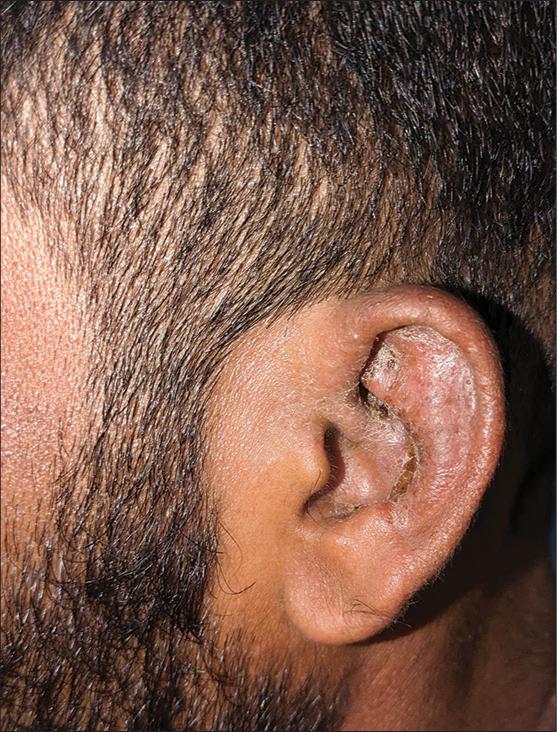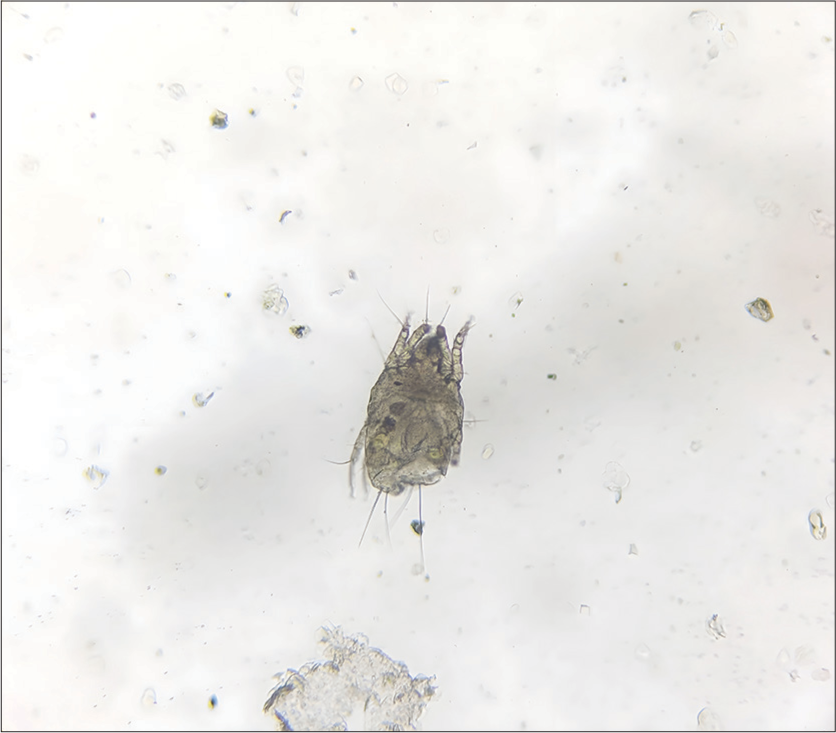Translate this page into:
Otitis externa caused by an exotic organism – Otodectus cynotis

*Corresponding author: Pradeep S. Nair, Department of Dermatology and Venereology, Government T. D. Medical College, Alappuzha, Kerala, India. dvmchtvm@yahoo.co.in
-
Received: ,
Accepted: ,
How to cite this article: Sathyanath A, Nair PS. Otitis externa caused by an exotic organism – Otodectus cynotis. CosmoDerma. 2024;4:102. doi: 10.25259/CSDM_116_2024
A 39-year-old painter referred from ear, nose, and throat presented with a scaly patch with crusting on the upper helix of the left ear suggestive of otitis externa [Figure 1]. There was no seborrhea. A scrapping mounted on potassium hydroxide demonstrated a mite identified by the entomologist from the mouth biting parts and forward appendages as: Otodectus cynotis [Figure 2]. This mite belongs to the Psoroptidae group infesting the ears of cats and dogs and is transmitted to humans by close contact with pets, causing otitis externa and a scabies like infestation. Our patient did not give a history of any contacts with pets, but transmission through fomites such as furniture is reported.[1] Our patient was a painter and had visited many houses, some with pets, and it is possible that he was infested by fomite transmission. The patient was started on ivermectin 12 mg/day orally, antibiotics, and topical mometasone. Antiparasitic drugs such as moxidectin, selamectin, and imidacloprid are used by veterinarians for pets.[2] We could not find any similar report in a review of English literature to the best of our knowledge.

- Scaly patch on left ear.

- The mite Otodectus cynotis demonstrated in 10% potassium hydroxide mount test.
Ethical approval
The Institutional Review Board approval is not required.
Declaration of patient consent
The authors certify that they have obtained all appropriate patient consent.
Conflicts of interest
There are no conflicts of interest.
Use of artificial intelligence (AI)-assisted technology for manuscript preparation
The authors confirm that there was no use of artificial intelligence (AI)-assisted technology for assisting in the writing or editing of the manuscript and no images were manipulated using AI.
Financial support and sponsorship
Nil.
References
- Occupational otitis externa in chicken catchers. J Laryngol Otol. 1997;114:366-67.
- [CrossRef] [PubMed] [Google Scholar]
- Human otoascariasis: Demographic and clinical outcomes in patients with ear-canal ticks and a review of literature. J Otol. 2016;11:111-17.
- [CrossRef] [PubMed] [Google Scholar]





